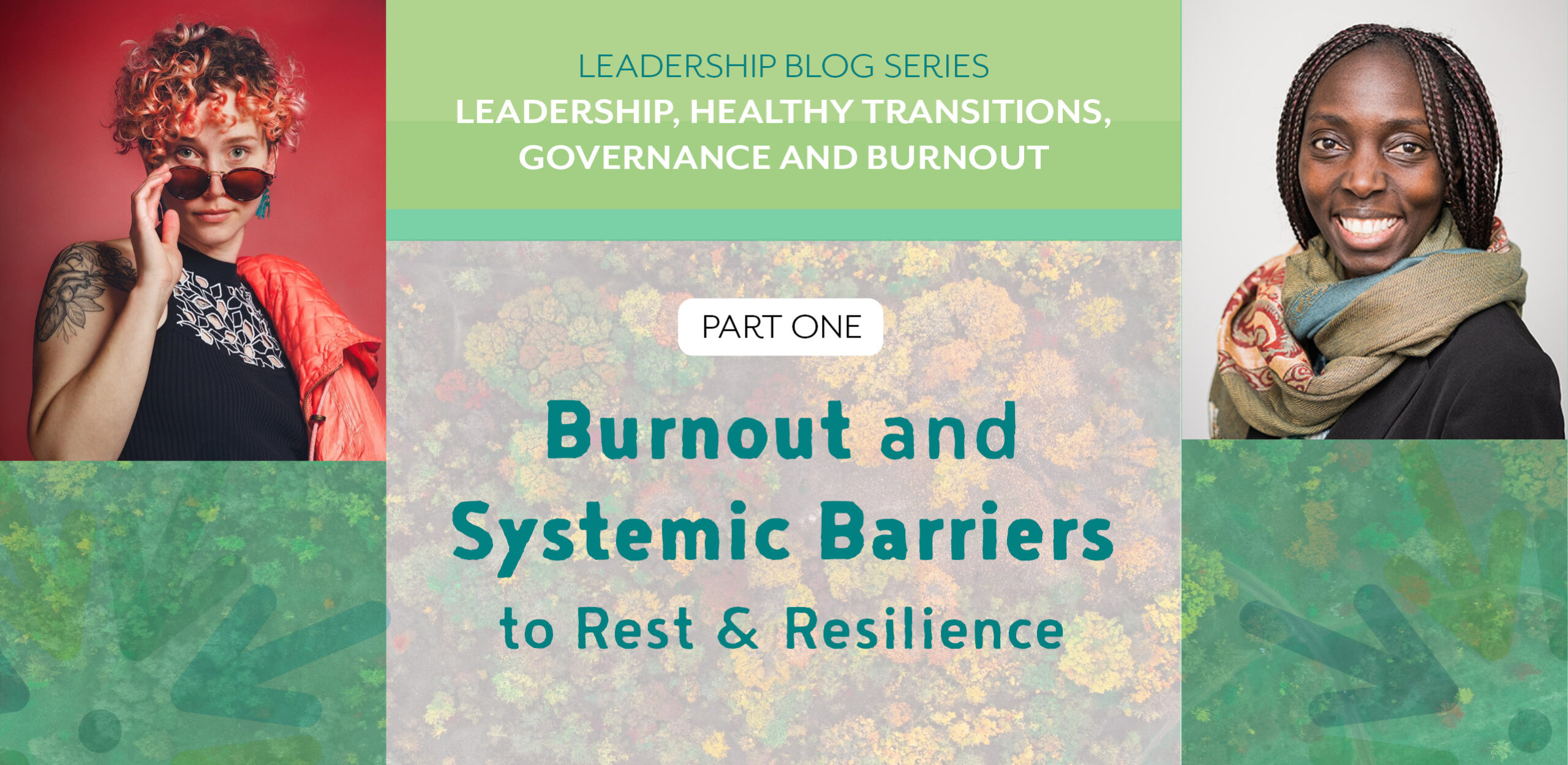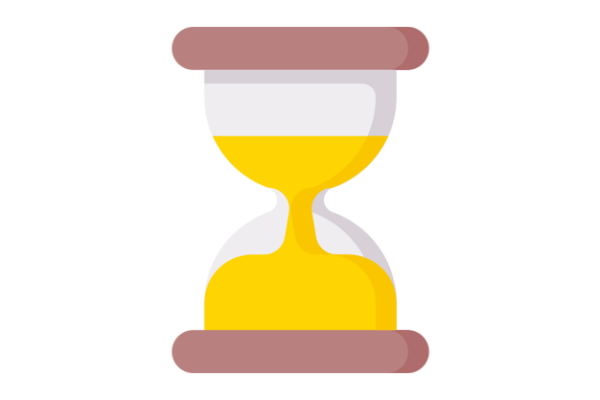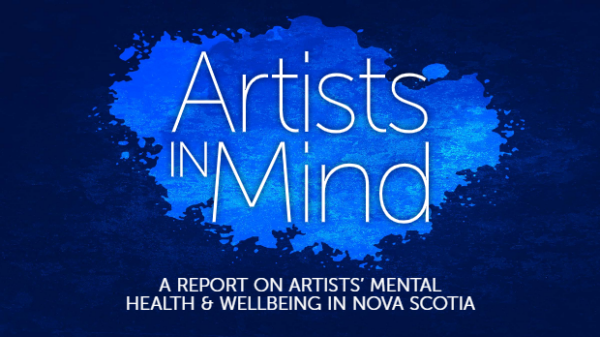Burnout and Systemic Barriers to Rest & Resilience

This post is the first in a series. Find the introductory post here. Inspiring Communities Executive Director Louise Adongo is joined in dialogue with Benny Welter-Nolan, a leadership and succession consultant who is, among other things, the past Executive Director of Visual Arts Nova Scotia with over a decade of experience in the cultural sector. This conversational blog series will share their reflections about their experience and insights into leadership transitions which support the ecology and plurality in our social purpose sectors.
In this series we will be talking about leadership, healthy transitions, governance and burnout. Why is it important to you to talk about these? And why together?

Louise: I’ve been burnt out before… it is from my own efforts and from my own over-extension. What was new for me in this experience, and what was different and more nuanced about this one, was that it was born of externalities somewhat outside of my anticipation or control. I walked into a glass cliff situation. And what seemed clear within the first 30 days was that what I thought I was going to be working on became very different from what needed to be addressed.
Bringing up these concerns with my peers and hearing that this is all pretty normal in nonprofit leadership and that you get used to it made me realize — this is why I’m burning out. I should not be getting used to what is, in any other context, systemic violence, lateral or otherwise. It should not be acceptable to work like this, and in other fields there would be accountability and consequences.

Benny: I wonder if it’s not just about the culture within the not-for-profit sector, but also the localized relationships within our smaller ecosystem. That we’re working within small communities where people’s relationships have a strong impact on the work. The flip side of building tight-knit community relationships is the barrier to changing the ways we work together.

I think you are right. Two other leaders went through exactly the same thing I did, even in other towns in Ontario and out West. So I think it’s not exclusive to Nova Scotia, but reflects how small the pool is in the community sector. People don’t want to burn bridges — they avoid conflict to maintain those relationships. I’m curious about the scarcity mindset of the nonprofit sector and if not reflecting on these dynamics is protecting and continuing these practices.
This is also something I struggled with a lot as a new leader. Your role is so much more public and there’s a lot more scrutiny. There’s a very limited number of people who have experience in that role that you can talk to and that will understand your situation. And a lot of those people don’t necessarily have values alignment either. So then having strong networks and relationships becomes really crucial for your survival. But on the flip side, you are trying to uphold your reputation, so these harmful norms are perpetuated to uphold these important relationships. This is why I didn’t turn around and walk out the door after finding out the real circumstances, because the reputational risk as the first Black leader in this type of context was too high. My internalized narrative was that the only way out of this was to fix it, because no matter what happens, you take the blame.

I do think that’s how leadership is structurally designed, especially in the charitable sector. The hierarchy that is imposed from the colonial and corporate governance systems means that any of the mistakes or challenges are ultimately the responsibility of a singular leader. That is both unsustainable and, really, the Board as a group is ultimately responsible, but the perception is often that the Executive staff are really responsible for the flaws. Then the Executive becomes Sisyphus, constantly pushing the boulder up the hill.
Not being able to move that core funding needle over three years of intensive advocacy was what tipped the scales for me on burnout.
Benny Welter-Nolan
Talk more about the effects of structure and hierarchy.

I wanted to share that hourglass imagery you use for nonprofit leadership hierarchies, which is so on point because it literally feels constricting. This morning I looked up the word anguish: apparently it has Indo-European origins and comes from the word “angh” meaning “tight, painfully constricted, painful.” It forms all or part of: anger; angina; angry; angst; anxiety; hangnail. It felt so good to read the description and have words to name and help me understand how I’m doing and to face some of what I’ve been carrying in my body over the last 24 months.

The pinch point of the nonprofit hierarchy hourglass being the Executive Director between the Board and staff of an organization. The one thing I would add is the frame around the hourglass – the container that is the ecosystem we work in. Because the other thing that absolutely contributes to my burnout is the funding systems and culture we work in. They are the container giving that shape and direction to the board and forcing that pinch point. It creates this pressure point on leaders experiencing the most force from all sides of an organization, creating a black hole of burnout.

There’s an expectation to take in everything from everyone in all directions when there is an opportunity here to be more expansive and supportive. And I think we do this by making building leadership laterally throughout organizations. I’ve been thinking about this hourglass metaphor and in trying to redesign how we collaborate on our collective vision and goals we need to tip this hourglass on it’s side.

In taking that hierarchy down and laying it out horizontally, adding more people to take on the responsibilities of leadership, we open up those pinch points and add some flow/ease/water, we turn the hourglass into a river or water cycle. It becomes easier for pressure to flow through when there are more channels. It’s also builds in sustainability so that when one channel gets clogged of debris, there are still a few other channels where things are still moving.
I’m also very curious about the kind of things that cause the overflow into burnout because it’s usually an accumulation without any pressure release. We’ve talked about sabbaticals as a potential solution some organizations are employing and how that hasn’t always worked out for us. People that come into these roles have incredible amounts of endurance and resilience and optimism. No one takes on these positions thinking it will be easy. But we’re seeing more than ever I think, that it’s gotten to a point where the expectations of these roles are no longer manageable. It takes an incredible toll on your body and burnout is a hard stop.
I think being a person with a chronic pain disability has actually helped to sustain me longer in a leadership role, because my body would give me a hard stop if I wasn’t taking care of myself consistently. Anytime I overextended myself, my body would literally force me to lie down and recover. More recently I’ve been able to access a prohibitively expensive medication through my benefits at work that really reduced the frequency and severity of my condition, but the shadow effect was that I could extend myself well beyond normal limits without my body keeping me in check.
Often, people attribute leadership challenges to individuals. What if the system is broken?
Louise: It’s interesting that we both experience governance systems contributing to our burnout as well as a community contribution. When did you recognize you were experiencing it?

The cultural sector had been advocating so thoroughly, and so consistently. I had never seen us come together in such a unified way to advocate for one thing, which was increased core operating funding. We engaged in all of the avenues of advocacy. We employed all of our strongest traditional methods to get our needs met through government meetings, research, and boards because our sector hadn’t seen an increase in funding from the Province of Nova Scotia in over 16 years. We were working at a 2006 level of funding — before most of us even had proper websites.

How mad is that? Even public servants have unions and managers get regularly scheduled raises. If professionals in other sectors don’t get their raises, they have avenues and tools to go on strike or advocate for it. So that society as a whole is accepting that a whole sector, which many people will say got us through the pandemic, has not seen an increase in core support for 16 years…!
For me, this is part of why I think we need to stop individualizing burnout and making it about leaders and their self-care, or when they are sending emails, and how many hours they’re working. We need to talk about how in our society it’s acceptable for some people to be extremely overtasked and under-supported. That’s part of why I’m excited to do this series, and part of what I want to bring into this conversation is – as a system, what are we saying and what are we really doing? It’s not just about whether that leader can cut it or what that leader could do differently. What are the structures, governance, and funding requirements that are a barrier? Why should people in their funding applications have to explain in detail why they need new software or staff salary increases to keep doing their work? Why aren’t there some things that are just a given in the budget templates and applications?
“Finally, funders should consider providing dedicated support to organizations led by Black, Indigenous and racialized people and those that provide programs and services specifically designed for equity-deserving communities. After all, the major goal of EDI practices is to transform society, not just nonprofits!”
Imagine Canada
In many other sectors, people won’t go a year without their salary. Or won’t go a decade without it increasing. So why is this normalized for the creative subsector of the social purpose sector? This is an inequitable practice that just isn’t feasible, and it’s impacting people and generations.

Right, and we had pursued so many avenues of consultations, etcetera, at high intensity over the last three years to advocate for moving the needle on operating funding. We agreed it was the priority because we could no longer sustain our operations and project grant administration fees weren’t even offering us enough to cover the staff time to write and report on the grant never mind managing the project. We’ve actually stopped applying to funding where we can’t include admin fees because we cant sustain it organizationally. We’ve begun writing to funders to let them know we won’t be applying if we can’t include operational fees to cover labor costs of administering the funding at a minimum.
We had actually received support from the arms-length arts council Arts Nova Scotia to create the Artists In Mind: Report on Artists Mental Health & Wellbeing in Nova Scotia during the pandemic. I worked very closely with the author and coordinator Eryn Foster on designing the report to provide many avenues for artists to connect with us and share their stories and needs. The report outlined that artists felt a real material lack of support from both government and individuals for the arts in our province, which was having a major impact on their livelihoods and self-esteem. I also really saw myself and my work reflected in that report because we had been marginalized in the budget for so long. Having your work valued and recognized and invested in is crucial to the sustainability of anyone’s work, but especially artists and creative practitioners.

Not being able to move that core funding needle over three years of intensive advocacy was what tipped the scales for me on burnout. Because I felt like my efforts were futile, and the message I was getting was that the arts aren’t valuable. Even the Premier effectively canceled the development of a new Art Gallery of Nova Scotia – designed by a team of BIPOC artists and architects – because “now is not the time” to be spending money on art. What I don’t think he realizes is that the cultural sector has been on life support since before the pandemic. People are giving their time for little to no money just to keep the doors of our cultural facilities open, and even then they are disappearing.
Louise: Your concerns about core funding are shared by many in the sector for sure. And then there are also funding disparities for women of color in leadership roles
Benny: This all felt really bleak during the pandemic, leaving me feeling ineffective and forcing me to take a two-month leave.

You reminded me of when I took my burnout leave and was talking to some Black leaders about my experience. They were crying because they didn’t even have the wherewithal to write a request for time off. I remember feeling like that, that I didn’t even know how to write the request. I helped people draft those letters during my own time off and knowing that people now have that template is helpful to me.
What’s really important to me in this series is to share with funders that they should build in time at the end of every project application to support the people doing this work to rest and recover. Treating people in the sector like automatons isn’t realistic. We need the foundational support in order to imagine and grow and thrive.

I think this is one of the key reasons we’re seeing such high turnover of EDs. It feels like for Executive Directors, the only way to take a break is to leave. The only option for a rest that is long enough to recover from the work, to pause, is out. We’ve seen an 80% turnover rate of staff and leadership at the Cultural Federations of Nova Scotia (a collective of eight provincial arts organizations) in the last three years. Some organizations have had leadership turnover twice since the pandemic.
One of the major barriers to rest as an Executive that I think we both experienced was that there is no avenue to take a break when you’re the one who usually coordinates time off for other people. The only reason I was able to take time off was because my doctors had referred me to a program which required me to take two months off work to attend. But even when I asked the health professionals how I would go about doing that with my work, they said that my employer had to allow the time off and you could just go to your boss or HR and they will help you. No one knew how to help me when I told them, but I’m HR, and also Finance, and the boss. It’s like no executive had ever taken a leave off work before. On top of that, my insurance prohibited me from taking disability because I had a pre-existing condition, which really confused all the administrators at the CRA, and it took me 14 months to receive EI. They kept having to confirm things with my employer, which was also me. You would think that would have made it more convenient but it delayed the process so much.
Most boards have no mechanism or guidelines to accommodate for the leadership to take a leave of absence. Thankfully my board and staff are all extremely supportive and competent administrators and were very generous with their time volunteering to take on parts of my role. Even with that, it still took me two months to coordinate dividing the responsibilities of my positions between ten people and orient them to the tasks at hand.
“…when I asked the health professionals how I would go about doing that, they said that my employer had to allow the time off and you could just go to your boss or HR […] but I’m HR, and also finance, and the boss. It’s like no executive had ever taken a leave off work before.”
Benny Welter-Nolan

Structurally, even the safety net systems of EI are not set up to support small organizations or even small businesses. The person who does this administration to support everyone else, doesn’t have the same kind of support system for themselves. Some people would say the board stands in that role, but it really depends on how healthy that board is and if they have any existing policy, governance or operational structure to support a leave.
Then, when you are experiencing burnout, you’re building the plane while you’re trying to fly it when you don’t have the space or capacity to do either. I not only have to plan my burnout, organize my rest, plan for the organization to accommodate my leave, then even when I get that time away, being contacted for emergencies that only I can solve because of course you can’t anticipate everything. So how do you plan the structures for your rest when you’re already burnt out?
This is why this cannot be individualized and why we’re talking about what needs to be different. What organizations and nonprofits as a sector can do to provide support to leadership. At a systems level, what is the structure that needs to be built for the social purpose sector? We are seeing some funders in America starting to offer funding for leadership sabbaticals but I have not seen that in Canada yet.
“How do you plan the structures for your rest when you’re already burnt out?”
Louise Adongo

I think that part of the reason why we are seeing such a mass exodus of leadership is because for generations we have relied on leaders being well resourced in their personal lives. We rely on their privileges and personal resources because our wages are exploitative.
The positive change we are seeing now is that we’re diversifying who is being hired into leadership, with different perspectives, styles, and ideologies that are often more relevant to the communities we’re serving. With lived experience of structural inequity, you don’t have the same kind of bandwidth to tolerate or uphold harmful systems, which is exactly why we need these leaders. There is an outdated expectation for leaders to be self-sacrificing for their jobs and making their work their personal identity, and working well beyond the scope of the contract.
What I see happening now is that we’re hiring people with less of a social safety net into an exploitative system and expecting them to operate at the same level of effectiveness with even greater expectations of dismantling systemic oppression on top of their regular responsibilities.

I’m glad you said that because it’s also not just that these leaders may not have the same financial resources, it’s class, social support networks. Access to wealthy philanthropists by phone or existing networks. We may not have the social cachet to get the funding in the same way as our predecessor. The Foundation for Black Communities “Unfunded” report, as well as New Power Labs “In the Dark” report and subsequent research elaborate on these realities.
The profile of the sector has changed and that’s a good thing, but the structural supports haven’t caught up. What we’re seeing is a succession issue across the sector because wages haven’t kept up, the workload is unmanageable, and truly the larger headline is This is the Sector that Stood Up and Delivered During the Pandemic. When almost everything else was shut down, this sector kept going, even into overdrive. And so for me, my personal burnout journey has included this disillusionment. We are seeing band-aid downstream solutions and Inspiring Communities is trying to address systemic problems upstream, but that’s not where the resources are directed, and it exhausts everyone trying to put out the fires.

We’ve discussed how our experiences of burnout and leadership have been different. I started my ED role before I was out, when I had a partner who worked outside the sector and supported the household in a way my salary couldn’t. My life circumstances changed so much before the pandemic and I wanted to acknowledge that being a single queer person transitioning during the pandemic was really alienating when the world was told to close their bubble to their household or immediate family. Maintaining the social system of the nuclear family unit didn’t reflect my life or social support needs. And then as I was transitioning I was interfacing with a lot of systems that wouldn’t acknowledge my reality, even in changing my ID–the government office couldn’t even guarantee that any government office would accept my new ID. This was also made harder by the fact that my role interfaced with so many government systems as well, and it was exhausting to have to assert my identity within the systems that don’t recognize my personal identity.
When I was on leave to attend the Nova Scotia Health program to address my burnout, every single person participating in the program with me was an equity-deserving person. And everyone delivering the program was someone with a high level of privilege. The contrast was very stark to me and I asked how we should go about addressing the stress of experiencing systemic oppression, they response was that they don’t address issues that are outside of your control, and that you should just focus on what you can change in your own day-to-day.
This really reflected my experiences of being dismissed in the health system. It’s designed and directed by people with significant privilege and it doesn’t account for the experiences of people outside that lens. The system doesn’t understand the politics of trauma, and how oppression impacts people’s health.
It really reinforced my perception that it’s not about healing, it’s about being socially compliant and a productive laborer for capital extraction.
[the health system is] designed and directed by people with significant privilege and it doesn’t account for the experiences of people outside that lens. The system doesn’t understand the politics of trauma, and how oppression impacts people’s health.
Benny Welter-Nolan

I filled out a survey about racism in the healthcare system this summer and I was curious about the design of this work; they were asking deeply personal questions through an anonymous survey and not offering any access points for people to deal with how sharing this information would affect them. I am curious about whatever happened with those survey results, and whether or not other avenues for collecting these stories were considered. Was this something that you also experienced and addressed with your research?

That was something we tried to be mindful of in the Artists in Mind Survey; to not be extractive and hold the gatherers of information at a distance beyond accountability for doing something with what was shared. We offered several different avenues to collect the data we used for this research, so people could share directly with us. The flaw in our process and approach was that we are artists and administrators, so actually collecting that data was extremely hard on our own health.
Hearing about the experiences of artists was really disheartening and really tipped the scales on my own burnout. Having to really face how the lack of support artists were experiencing was putting them at extreme risk. And then knowing that these stories won’t necessarily affect any change. Not nearly soon enough anyways.

I don’t think we talk about how hard that is on administrators. The moral injury of what we experience in certain contexts such as when you’re applying for funding, knowing the stories of the people you’re serving, and how funding rejection can really impact you when those needs are invalidated.
I have to say; particularly following ongoing conversations I am having with people throughout the sector. I really want to shout out non-profit leaders regardless of their level of privilege or intersectional identity because many leaders are feeling this pain point. And the system that supports and perpetuates it.

So, to borrow a question from Future of Good in the social media post about Imagine Canada’s report on Shifting power dynamics: equity, diversity and inclusion within the nonprofit sector: what should non-profit leaders do in the next 90 days?
Louise: Rest. People underestimate the burnout of, and impact on, leaders in the nonprofit/social purpose/ community sector. And that the leaders need rest.

Agreed. And I think it’s also important to understand when you break, how you break, and how to recognize the early distant warning signs of your body so that your crash doesn’t take everyone else out with you. I don’t think we can always see it coming, my staff was starting to be demotivated and that’s when I noticed how my burnout was affecting them and I needed to reset.

You’re right, leadership burnout impacts the entire sector, not just equity-deserving leaders. And I must say that from my experience, by the time the leader is asking for an avenue for rest they are already tapped out and should not need to justify it. They have already exhausted all their own coping mechanisms and resilience. I think this is why, as you have expressed, there is high turnover and reticence by BIPOC leaders to enter or continue in the sector.
Take this as a love letter to rest. Bring it to your board or let us help you get the time off you need.
Go to the beach, today is your day off.
We’d love to hear your reactions to this conversation so far. You can share comments below, or comment on our Facebook or LinkedIn posts. If you would like to share your experiences discreetly, you can do so by sending to cboyce@inspiringcommunities.ca.
READ THE NEXT POST IN THIS SERIES
Links to reference articles and resources
Share this:
1 Comment
It strikes me that there is a leadership and succession challenge in all fields — government, institution, corporate and nonprofit. And it feels like it directly relates to two things:
1. The capitalist /colonial imperative to grow at all costs has created a scarcity mentality and systems that are bent to the point of breaking from trying to constantly grow.
2. The systems were originally designed for and by White men, who may have been oblivious to, or unfazed by, things that women, BIPOC / racialized leaders, Queer leaders, experience as damaging. They didn’t know any other way to be than to be a competitive bull-in-china-shop, moving through the world like they owned it (because they effectively did). Now that racialized leaders and others with intersectional diverse identities have modeled new ways to inhabit these spaces, even the traditional leader types are realizing how toxic the system they built has become.